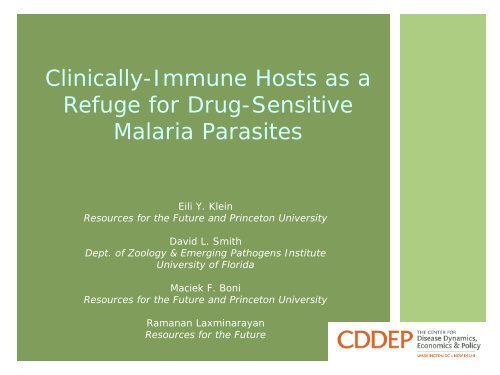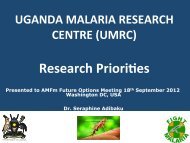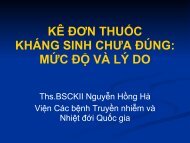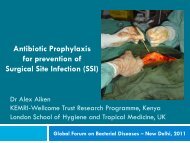Download this tool
Download this tool
Download this tool
- No tags were found...
Create successful ePaper yourself
Turn your PDF publications into a flip-book with our unique Google optimized e-Paper software.
OutlineMalaria Parasite Life-CycleEvolution of Resistance to MalariaPopulation Genetics ModelsHistory of Epidemiological ModelsTwo-stage model for transmission of drugresistantmalaria parasites
Parasite Life-Cycle
Basic ReproductiveNumber (R 0 )Basic Reproductive NumberThe expected number of infected mosquitoesthat will eventually arise from one infected mosquitoafter one complete generation of the parasite.R0=2 −gnma bcerg
Plasmodium falciparumParasite Rate (PfPR)Plasmodium falciparumParasite Rate (PfPR)Proportion ofHumans InfectedSporozoite RateProportion of Mosquitosthat are Infectious
Entomological InoculationRateEntomological Inoculation RateThe Number of Infectious bites received per day by a human
Malaria ImmunityPREVENTS INFECTIONInfection Blocking: infection of humansTransmission Blocking: infection of mosquitoesPROTECTS AGAINST CLINICAL MALARIAPremunition: asymptomatic infectionAcute-Phase: recent clinical episodeFunctional Immunity: age & exposureBlood Stage Immunity: age & exposure
Evolution of Resistance De novo mutation rate Spread of resistant parasitesPayne 1987 Parasitology Today; Wooten et al 2002 NatureWorld Malaria Report, WHO 2005
Population GeneticsModelsReasons for resistance emergence inlow transmission settingsA higher frequency of resistant alleles (mutationselectionbalance) (Hastings Parasitology (1997) 115:133-141)More drug treatment (per parasite) (White and Pongatavornpinyo Proc R Soc Lond B (2003) 270:545-554)More selfing (Dye and Williams Proc R Soc Lond B (1997) 264:61-67; Hastings Parasitology (1997)115:133-141)Mutant parasites are less likely to survive a hostimmune response when immunity is betterdeveloped (Gatton et al Parasitology (2001) 123:537-46)
Epidemiological modelsRoss – 1910 Macdonald – 1957
The Garki ModelInfectiousPositiveNon-InfectiousPositiveRecovering FastIncubatingNon-InfectiousPositiveRecovering SlowlyIncubatingNon-ImmuneNegativeImmuneNegative
SIR ModelHuman PopulationSusceptibleInfected(Sensitive)ImmuneInfectiousInfectedSusceptibleMosquito PopulationKoella and Antia, Malaria Journal 2003, 2:3
SIR Model with ResistanceHuman PopulationInfected(Resistant)SusceptibleImmuneInfected(Sensitive)InfectiousInfectedSusceptibleMosquito PopulationKoella and Antia, Malaria Journal 2003, 2:3
Immune IndividualsAre InfectedPrevalence of P. falciparum (trophozoites/gametocytes) by age and seasonDietz, K et al. Bull Wld Hlth Org (1974) 50:347-357
Immune IndividualsTransmitInfectiousness to Mosquitos by AgeGitheko, AK et al Trans R Soc Trop Med Hyg ( 1992) 86, 355-358
Two-Stage SIS ModelResistant InfectionsInfected(non-immune)θInfected(semi-immune)r x2Susceptible(non-immune)γr x1h w (1-ξ 1 ) h w (1-ξ 2 )h xh xSusceptible(semi-immune)ρ 1 +r w1Infected(non-immune)θInfected(semi-immune)ρ 2 +r w2Sensitive Infections
Model Equations(1)S&= B+ γ S + I ( ρ + r ) + I r −S ( h (1 − ξ ) + h + μ)1 2 w1 1 w x1 x 1 w 1 xI&= S h (1 −ξ ) − I ( ρ + r + θ + μ)w1 1 w 1 w1 1 wI&( )x1 = S1hx − Ix 1rx+ θ + μS&= I ( ρ + r ) + I r −S ( h (1 − ξ ) + h + γ + μ)2 w2 2 w x2 x 2 w 2 xI&= S h (1 − ξ ) + I θ − I ( ρ + r + μ)w2 2 w 2 w1 w2 2 wI&( )x2 = S2hx + Ix 1θ− Ix2 rx+ μ
Model With No Resistance
Model With No Resistance
R 0 – Again!Basic Reproductive Number (R 0 )The expected number of infected humans that willeventually arise from one infected human afterone complete generation of the parasite.The Replacement Number (R X )The expected number of infected humans that willeventually arise from one infected human afterone complete generation of the parasite when theprevalence of infection is X.
A Refuge forSensitive ParasitesThe Replacement NumberR 0 resistantparasiteImmunesensitiveindividualsR resistant parasiteLog of Vectorial Capacity
Fitness cost of Resistance
ConclusionAsymptomatic semi-immune individuals provide arefuge for sensitive parasites and can prevent thespread of resistant parasites at high transmissionlevels assuming a great enough fitness costImplications for control strategies aimed atreducing the transmission level (ITNs, IRS)Unlike models of antibiotic resistance (Bonhoeffer,Lipsitch et al. 1997), the parasite with the highestR 0 may not predominateAllows for coexistence of both sensitive andresistant parasites
















